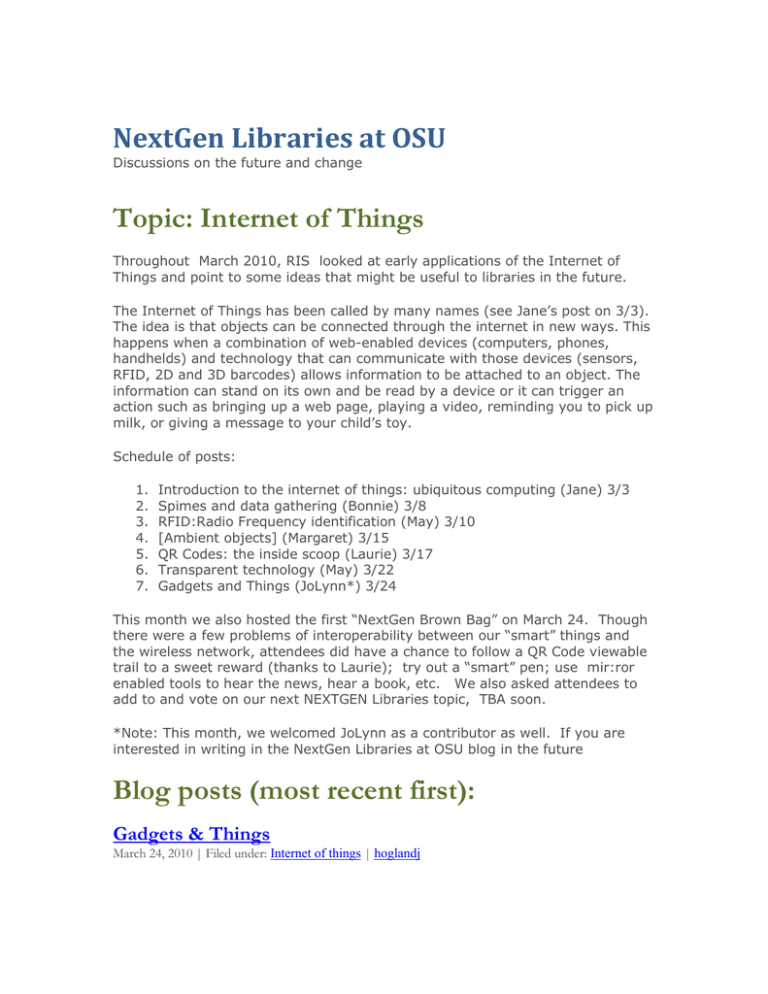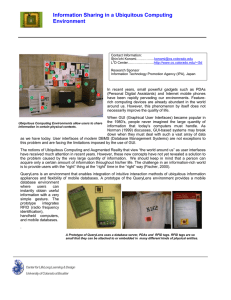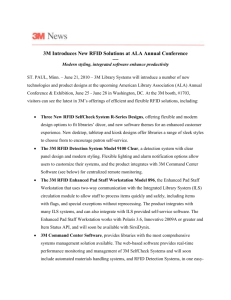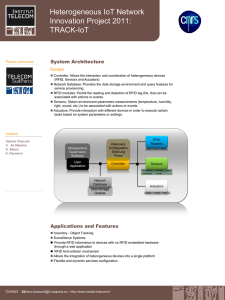NextGen Libraries at OSU Topic: Internet of Things
advertisement

NextGen Libraries at OSU Discussions on the future and change Topic: Internet of Things Throughout March 2010, RIS looked at early applications of the Internet of Things and point to some ideas that might be useful to libraries in the future. The Internet of Things has been called by many names (see Jane‘s post on 3/3). The idea is that objects can be connected through the internet in new ways. This happens when a combination of web-enabled devices (computers, phones, handhelds) and technology that can communicate with those devices (sensors, RFID, 2D and 3D barcodes) allows information to be attached to an object. The information can stand on its own and be read by a device or it can trigger an action such as bringing up a web page, playing a video, reminding you to pick up milk, or giving a message to your child‘s toy. Schedule of posts: 1. 2. 3. 4. 5. 6. 7. Introduction to the internet of things: ubiquitous computing (Jane) 3/3 Spimes and data gathering (Bonnie) 3/8 RFID:Radio Frequency identification (May) 3/10 [Ambient objects] (Margaret) 3/15 QR Codes: the inside scoop (Laurie) 3/17 Transparent technology (May) 3/22 Gadgets and Things (JoLynn*) 3/24 This month we also hosted the first ―NextGen Brown Bag‖ on March 24. Though there were a few problems of interoperability between our ―smart‖ things and the wireless network, attendees did have a chance to follow a QR Code viewable trail to a sweet reward (thanks to Laurie); try out a ―smart‖ pen; use mir:ror enabled tools to hear the news, hear a book, etc. We also asked attendees to add to and vote on our next NEXTGEN Libraries topic, TBA soon. *Note: This month, we welcomed JoLynn as a contributor as well. If you are interested in writing in the NextGen Libraries at OSU blog in the future Blog posts (most recent first): Gadgets & Things March 24, 2010 | Filed under: Internet of things | hoglandj Handheld PDAs, smart watches, Notebooks, laptops, tablets, cell phones, smart phones, MP3 and video players, digital still or video cameras, pocket scanners, document pens, game machines, GPS devices, jump drives, RFID, etc. The list goes on and on and everyone owns at least 3 of these devices. It only makes sense to consider these when looking at ways library services are accessed and used. I remember watching a SciFi movie when I was a kid and laughing because they had a device that talked, got information, scanned humans and things, turned on the Wall Screen (TV?) and unlocked their door. Back then it was ―Yeh sure, that will never happen‖ but guess what, it has happened! I can‘t wait for the day when my hand-held device will do everything for me. For one thing, it will be a lot cheaper than multiple gadgets. By the time I‘ve saved up to get that new gadget, it is almost obsolete even though the price may be down since it has been on the market for the past six months. But now there are newer, better things out there – and I have to settle for this ―old‖ thing. Who knows what this gadget-enabled future may bring for us as individuals or as a library. JoLynn O‘Hearn for RIS Transparent technology March 22, 2010 | Filed under: Internet of things | averyb OSU engineers create world‘s first transparent transistor 03-24-03 http://oregonstate.edu/dept/ncs/newsarch/2003/Mar03/transparent.htm This technology was first developed in the 1960s. It is made from Zinc oxide which is cheap, safe and easy to work with. This compound is transparent can be deposit in thin layers at low temperature. It is environmentally benign. The current research is based on the graduate research undertaken by Randy Hoffman, Ben Norris and other co-workers at OSU. Applications World‘s first transparent integrated circuit created http://dataweek.co.za/article.aspx?pklArticleId=3890&pklCategoryId=31 Major advance made in transparent electronics http://www.scienceblog.com/cms/node/6562 (note: link no longer current6/7/10) 1. Transform flat panel display glass to accommodate new circuits or functions. 2. Improve quality of liquid crystal display (more clear and bright) 3. Allow transmission of visual information built into window glass or windshield of automobiles 4. Inexpensive electronics for use in disposable devices. 5. Efficient solar cells (less expensive) 6. Imaging and printing My interpretation on this technology‘s impact on the future of the library 1. The capability to transmit visual information on to transparent surface is very valuable to libraries. Imagine we can go anywhere with a transparent thin film in our hands and get information. Or, we can park our cars in the park or beach and study the information show up on the windshield. How does this place the existing hand held device? 2. The anticipated efficient but inexpensive solar cell may make an impact on the utility bill for the future libraries. 3. The most immediate influence perhaps is the imaging and printing aspect of this technology. –May Chau for RIS Internet of Things Videos March 17, 2010 | Filed under: Internet of things | mellinma Here are links to a couple of YouTube videos, one quite short (and flavored by the IBM brand) and one longer (and flavored by the Google Brand) Internet of Things (IBM Social Media, 5.24 minutes) Internet of Things: What is a Spime….(Google Tech Talk by Bruce Sterling. Long – 49 plus minutes -Margaret for RIS QR Codes – The inside scoop | Filed under: Internet of things | bridgesl In December I worked with Kim Griggs to develop a presentation about QR Codes which I delivered to our library faculty and staff. In the presentation I cited the work of Huddersfield Library in the UK. This month I followed up with Andrew Walsh, the project leader of the QR Codes effort at Huddersfield, and asked him how the response has been. In reply, Andrew said, ―I think the best way of summing up how they‘ve been received is ‗ignored‘! There seems to have been a general unwillingness to experiment with them.‖ Andrew shared with me an internal report he put together for his library. In the report he highlighted some key points including: Awareness of QR codes increased from 8% to 22% over life of project, with an additional 11% aware of them, but unable to identify what they were for. Disappointing usage of QR codes amongst library users. For more information about the promotion and use of QR Codes at Huddersfield, visit Andrew‘s presentation on slideshare. Although Andrew‘s experiment with QR codes hasn‘t met with the reception he hoped for, it‘s possible the tides will turn. Recently, Google unveiled their ―Favorite Places‖ program which uses QR Codes to link the physical location of a restaurant to reviews online. A marketing mega-giant like Google getting behind the use of QR Codes may be the push the technology needs. –Laurie Bridges for RIS Ambient objects March 16, 2010 | Filed under: Internet of things | mellinma You may have noticed the pervasiveness of computing power in many objects we use every day like automobiles, phones, toys and appliances. When those objects are also connected to the Internet, they can transmit and receive data about a community. When people in a community have an easy way to compare their behavior with their cohorts, that can change human behavior. Wide Tag Social Energy Meter Lamp For example, the lamp pictured here is designed to help its owners monitor their real-time consumption of energy and compare it to that of their community. A sensor is placed at the beginning of the home energy system that sends signals to the lamp. The lamp transmits data to the energy company which in turn sends data back to the lamp. The home energy use is displayed at the bottom 7/8s of the lamp, and the average community use is displayed at the top 1/8 of the lamp. Home owners can instantly compare their energy use to that of the group by glancing at their lamps. When the large part is red, the home owners‘ energy use is higher than that of the group, which in this photo displays as blue. Those whose energy use is higher than their neighbors have the opportunity to change their behaviors to lower their energy use. The company doing this work is called Wide Tag. Another company that produces ambient objects is called, appropriately, Ambient Devices. They have a number of products that integrate internet information with daily objects such as alarm clocks that give up to the minute weather information, orbs or other colored lights that change as the stock market rises or falls, or umbrellas that light up when rain is predicted. O2 Joggler is a device that can serve as a family hub. It is essentially a touch screen monitor that is connected to the internet. The O2 Calendar is a centralized family calendar that can be synchronized with online calendars and send updates to family member‘s phones or other mobile devices. You can use it to display photos and videos, to play internet radio, and give you news, sports and traffic updates, as well as weather forecasts. From the Joggler you can send and receive text messages. Chumby is a cute little device that is essentially an internet clock radio. You can use it as an alarm clock, but you can also play your Pandora radio stations on it, or display photographs of your loved ones, or download hundreds of different applications. For example, there is a widget called ―recipe fetch‖ that will display a single recipe. I‘m interested in how ambient objects take data and display it in a more visual way where users can glance at the device and understand that something has happened — it‘s a visual way to be alerted about an update, a trend, a message from someone. I‘m not quite sure how applicable ambient objects are for libraries at this point, but one example we are already using is the updating display of computer use in the Learning Commons. It might be nice to be able to see at a glance how many laptops are free to check out, or how many study rooms. Margaret Mellinger for RIS RFID March 12, 2010 | Filed under: Internet of things | averyb Radio Frequency Identification (RFID) uses radio wave technology to tag a product, animal or person. It uses an object as a device, known as RFID tag. It has been applied for a while, such as the microchip identification for pets. Mir:ro is a RFID reader, the objects of choice are Ztamp:s and Nabaztag. It is a product of a company named VIOLET. It has everyday application because the Ztamp:s can be attached to anything (e.g. a teacup, a car key etc.). Other applications include control of iTunes, Skype, send e-mail, and update status on social networks and made the computer read pages from books. It works even when the computer is off. This product comes with a round mirror like device, it will prompt your computer to perform task you requested. We have ordered a set of Mir:ro, it comes with 1 mirror resemblance disc, 2 small Nabaztags and 8 stamps and 1 book from Ladybug publishing. a Wi-Fi (compliance with wireless network with IEEE standards) enabled device in the form of a cute bunny. Nabaztag is a smart object which can connect to the Internet (e.g. download news, read email etc.) During the test run, I stick a Ztamp:s on a rubber toy at my desk. I then go to violet.net and key in a URL. I download a YouTube segment, and it plays well. All I need to do is to wave the Ztamp:s on my rubber toy on top of the mirror, and the YouTube will play automatically. The Nabaztags also read the news for me, although it was not the news of my choice. It is because I did not select any. The disappointing thing is that the Nabaztags we ordered do not read from books that come with the order. When reading that this RFID reader allows the computer to read from books, it sounds like a good device for our visually challenged patrons. However, we need a bigger Nabaztags to do the job. Most importantly, the Nabaztags can only read books that are already audibly available online. I see many potential in this product, but many improvement need to be made. Last year, the company Violet had filed bankruptcy which indicates some trouble in the future of this product. But this product is still in business, perhaps, more improvement can be on its way. For me, this is a fun product so I decided to play with it a bit more and test its potentials. I see many potential in smart object and its applications in library, so, I think keeping an eye on this line of products may be worthwhile. –May Chau for RIS Spimes and Data Gathering. March 7, 2010 | Filed under: Internet of things | averyb For me the internet of things sounds ominously like a reason to get more ―stuff.‖ But after some reading I realize it is really more about ―stuff power.‖ Spimes, a contraction of ―space‖ and ―time‖ was coined in 2004 by Bruce Sterling for the next generation of objects/things. These ‖self-aware‖ objects that have the attribute of ―knowing‖ precisely where they are in space and time. By extension they can interact with other spimes by exchanging data — one hopes for good. Picture socks pairing up in your dresser drawer or before the exiting the dryer. This achieved after programming them to locate themselves and each other in space. Add to that data gathering tool a decision algorithm and a means of sending that data or decision to another spime and you have your smart refrigerator telling your e-shopping list that it‘s time to order milk, and perhaps that you have gone through that stash of chocolate at a higher rate than normal (again) and until your treadmill reports some regular use that drawer will not open. Thing-power!!! Just before writing this I downloaded ―datalogger‖ onto my iPod. ―Datalogger‖ uses Pachube.com: “a realtime data brokerage for sensor, energy, and environment data from objects, devices and buildings around the world…[it] provides a suite of applications for visualizing, mapping, and making sense of the data you have stored” and also for sharing that data via email, website widgets, and social networking platforms. So, will we and our spimes use this data gathering for good, entertainment or something else? Even the perception of data gathering can raise trust and privacy issues. Recently I left a store and was looking at the label on some berry plants which happened to be by the bumper of a van. The man in the van open his door asked me what I was doing, and I said, ―looking at the labels on these plants,‖ to which he replied, ―oh, I thought you were taking a photo of the front of my car, and I don‘t let anyone do that.‖ I left bewildered in that all I had in my hand were my car keys — but perhaps he thought my glasses were those new ones with the built-in ―point and blink‖ camera. I don‘t really have a need to data gather at the moment — certainly not the example offered in the ad to monitor my coffee consumption. But their other examples remind me of the historically important role of the citizen scientist (Ben Franklin, etc.) and their 21st century counterparts (see some examples at http://www.birds.cornell.edu/netcommunity/citsci/projects). This makes me wonder, as local data gathering becomes the norm in households would/should public libraries assume some responsibility for preservation of that data or encouraging that it be preserved? Meanwhile here are some sources and keywords: WideSpime, OpenSpime, spime management systems. Sources: Churchill, E. F. (2009) ―Ps and Qs: On trusting your socks to find each other‖ Interactions (ACM) 16(2): 32-36. (available at: http://doi.acm.org/10.1145/1487632.1487640) — Discusses the need for research centered on infrastructure policy and network security and ―to actively promote a view of the internet of things world in terms or socio-technical, emotional networks of trust, reliability, and confidentiality. Not simply a world of consumer devices, simple and innocent nodes in the networks within and between which information flows.‖ Department of Computer Science and Engineering. University of Washington. [2010] RFID Ecosystem Project : ―Investigates user-centered RFID systems in connection with technology, business, and society. Past research on user applications of RFID has been limited to short-term technology and user studies in restricted scenarios. In contrast, the RFID Ecosystem provides a living laboratory for long-term, in-depth research in applications, databases, privacy, security, and systems.‖ (quoted from site). Sterling, Bruce, ―Meet the Spime‖ in Shaping things (Cambridge, MA: MIT Press, 2005) pp: 76-[84] (available at: http://mitpress.mit.edu/books/chapters/0262693267chap10.pdf and OSU Valley T174.S77 2005, Chapter 10) Wallis, Dan [2009?] ―How to build your first spime management systems‖ (available at: http://www.slideshare.net/uxcrank/how-to-build-your-first-spimemanagement-system) — Slideshare presentation covering Sterling‘s artifact to spime evolution and a museum application. –Bonnie Avery for RIS Ubiquitous Computing March 3, 2010 | Filed under: Internet of things | nichojan What is Ubiquitous Computing? Marcia Riley‘s description of ubiquitous computing flips the focus from the user, us, interacting with a machine to a world where our world is embedded with smart technology. If this sounds Orwellian, it sort of is, but intended to be friendly and responsive to our desires. For example, your coffee pot becomes aware of–not in a creepy way of course–when you wake up and makes you a cuppa. Mark Weiser is seen as the originator of the concept of ubiquitous computing based on his 1991 Scientific American article. Some alternate names are: ubicomp, calm technology, pervasive computing, ambient intelligence, and the Internet of Things. I like Wikipedia‘s definition because it focuses on the core concepts shared among the variant models of ubiquitous computing: ―All models of ubiquitous computing (also called pervasive computing) share a vision of small, inexpensive, robust networked processing devices, distributed at all scales throughout everyday life and generally turned to distinctly common-place ends.‖ Another way to express this comes from Stringer, et al., ―Successful ubiquitous applications augment existing valued interactions rather than seeking to replace them.‖ You may not realize it, but practical applications of ubiquitous computing surround us as highlighted by Mike Kuniavsky, in his keynote address at the North American Serials Interest Group 2008 conference. His concept of ―information shadow‖ aptly describes this new phase of computing. A contemporary example is an Adidas shoe which contains a chip that analyzes surfaces and then adjusts the shoe. What stuck out for me is Kuniavsky‘s comments about how ubiquitous computing serializes everything, how libraries are skilled at managing information and that these skills make us qualified to ―corral, label and organize the information shadows‖. Nice to know we still have a place in the world, isn‘t it? Jane Nichols for RIS By Hamed Parham (http://www.flickr.com/photos/hamedparham/3328144733)






